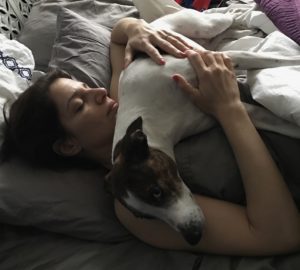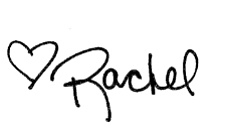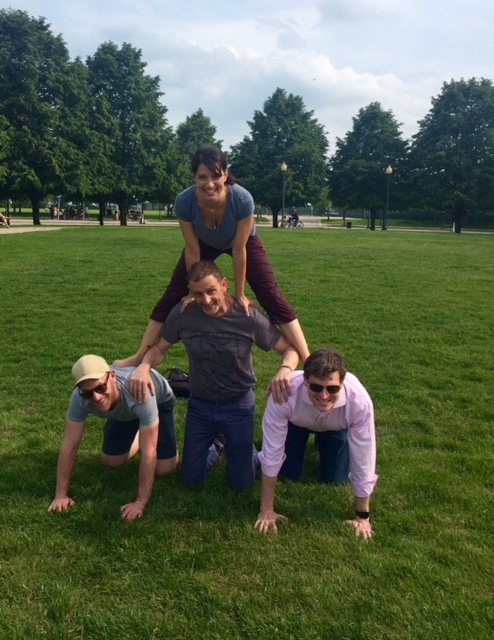You feel panicky for no reason. It comes out of nowhere…
Your heart is pounding out of your chest.
Your breath is shallow and quick.
Your body feels like it’s overheating.
You can’t think straight – the world is spinning.
You’re dizzy and scared.
You feel trapped in your body, out of control… and you feel like you’re going to die.
If you’re experiencing these symptoms, it’s likely that you’re having a panic attack.
Panic is a whole-body experience!
Your body needs tools how to stop panic attacks for good and stop the madness!
Here are my favorite MindBodyWise Panic Attack Tips
to slow down your system instantly…
BREATHING METHODS:
- Paper Bag Method – Cover your nose and mouth with a paper bag. Breathe as deeply as you can through both your nose and mouth (inflating your belly and chest) for at least a minute.
Why this works: When you hyperventilate, it means your body has too much oxygen which stops you from retaining carbon dioxide. This excess oxygen makes you feel short of breath. The paper bag breathing technique traps carbon dioxide in the bag, so when you inhale into the bag, you absorb carbon dioxide-rich air, which then allows you to fully absorb the oxygen that’s entering and stops the hyperventilation.
2. Hold your breath – If you hold your breath for 15-20 seconds (repeating this a several times), it helps to slow your heart and calm your hyperventilation quickly.
Why this works: Holding your breath prevents the release of carbon dioxide. Similar to the Paper Bag Method (above), holding in carbon dioxide allows the oxygen that’s entering in to be used in your body, instead of having an excess – which is what causes hyperventilation in the first place.
3. Conscious 1:2 Breath – Even though it may feel challenging, aim to breathe consciously. Bring your hands to your belly (not your chest, as you’ll feel your fast heartbeat and this sensation may induce more anxiety), and feel your inhales and your exhales inflate and deflate. Try to double the length of your exhale, which is proven to slow down your central nervous system.
BODY METHODS:
4. Get Present – The best and easiest way to get present is to use what you already have – your body. This is most easily accomplished while sitting in a chair. With an open palm, tap your body beginning with your feet. Feel the sensation of your hands against your body and your body receiving the touches and taps. Take your time to notice the experience in its entirety, moving from toes to head. Experiment with different levels of pressure and soft fists versus open palms.

5. Ground Yourself – Lay on your back, on the floor with weight on top of you. When you are panicking, it can feel like you are floating off the ground and into the ether. Feeling your body supported by the firmness of the floor with a heavy pillow or blanket on top of you (or your dog) while breathing deeply can help to flip the switch on your panic quickly.
6. Move – Jump! Dance! Walk! Run! It doesn’t matter which you choose – what matters is that you get your body moving. The trapped feeling that comes with panic is much more easily dissipated when you get moving. It might be challenging, while in the midst of panic, to get yourself out the door, but if you can muster the courage – it could be your saving grace.
7. Eye Pillow – Light pressure on and around your eyes is a great way to stop panic in its tracks. Use an eye pillow and if you aren’t hypersensitive to scent, purchase an eye pillow with lavender scent for bonus calming effects. Another, more intense, option is to use a cold eye mask. The cold temperature with the light pressure can be an effective way to stop panic in its tracks.
Why this works: The vagus nerve (this is the nerve that controls your fight/flight/freeze response) is easily stimulated in the area around your eyes. Light pressure and cold temperature soothe this nerve instantly send a signal of safety to your whole body.
8. Laugh – Did you know that it’s nearly impossible to laugh and panic at the same time? So, if you can make yourself laugh (even if it starts off as a fake laugh), you can ward off an on-coming panic attack. Start with an exaggerated fake laugh, if you can’t get a real one going, and see where it leads. The louder and sillier you can get, the better.
MIND METHODS:
9. Distract Yourself – With mild panic it’s possible to distract yourself to stop the sensation of anxiety. Turn on an upbeat song you like, a TV show that engrosses you or that makes you laugh. It’s best to make a list of these before you have the panic attack, so you have your go-to distractions ready and no thinking is required (remember: panic lowers your ability to think clearly).
10. Remind Yourself – If you can, even in the midst of the chaos of your panic, remind yourself that just like everything else in life – nothing lasts forever. This feeling and sensation will pass, just like all feelings and sensations do.
EXTREME METHOD:
11. Ice Dunk – This is only suggested for when you’ve tried everything else and you are in extreme panic mode. If you have a heart condition or an eating disorder, do NOT do this. Fill a wide bowl with 1/3 with ice. Add cold water, leaving some room at the top. Take a deep inhale and then plant your whole face into the water for 30 seconds. Make sure you get the check bones and above your eyes fully immersed in the icy cold water, as these are key areas that connect with the vagus nerve (fight/flight/freeze response).
Why this works: This physically halts the panic, by forcing the parasympathetic nervous system to turn on (regulated by the vagus nerve) and it slows your heart instantly, which has a relaxing effect on your whole body.
AVOID:
The following list includes some of the most common triggers for anxiety and panic, so stay away as much as possible from: caffeine, sleep deprivation, dehydration, smoking, narcotic drugs and alcohol.
Panic attacks don’t have to be a life-sentence!
P.S. If you’re prone to panic and want to learn to get over fear and anxiety, I’d love to work with you! You can go on to live a joyful, panic-attack-free life. Yes, this is absolutely possible (I’ve worked with many who will attest)! You will learn how to stop anxiety and panic attacks forever.
P.P.S. To continue the conversation and share/listen/learn/connect, join me and a group of others just like you in the free MindBodyWise Living Room group on Facebook. I hope to see you there!





